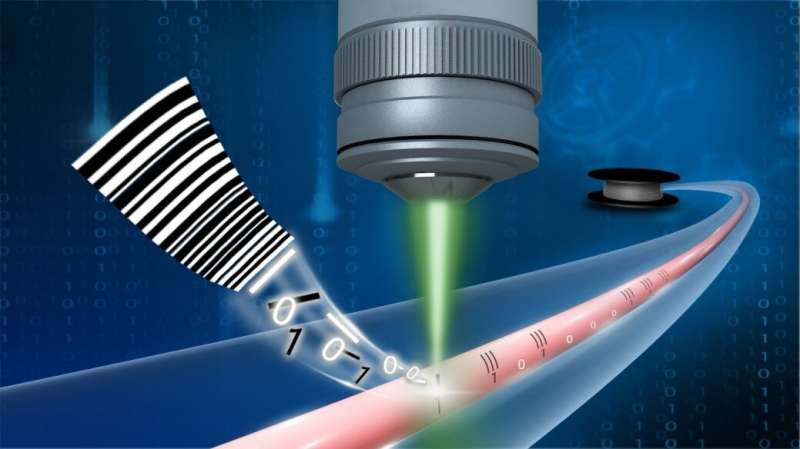This article has been reviewed according to Science X's editorial process and policies. Editors have highlighted the following attributes while ensuring the content's credibility:
fact-checked
proofread
Scientists propose an all-optical labeling method for encrypted fiber optic tags

Fiber sensing scientists from Shenzhen University have developed an encrypted fiber optic tag that can be used for all-optical labeling and recognition of optical transmission channels such as access networks.
Publishing in the journal International Journal of Extreme Manufacturing, the team led by researchers based at the Guangdong and Hong Kong Joint Research Center for Optical Fiber Sensors proposed an all-optical labeling method with encryption property, which uses the feature information and spatial distribution of fiber Bragg grating arrays to flexibly store different coding sequences.
Unlike traditional optical link labeling methods, the all-fiber tag proposed by the team fully utilizes the characteristics of the optical link to achieve all-optical reading, recognition, and restoration of link information. The findings could have a significant impact on the maintenance of optical distribution networks.
The fiber optic tag is based on a fiber Bragg grating array prepared by femtosecond laser direct writing. By cleverly utilizing the spatial distribution, reflectivity, and reflection wavelength of the gratings, the tag can carry rich information. When using an optical time-domain reflectometer for reading, a specific administrator can perform complete and error-free information recovery.
One of the lead researchers, Professor Changrui Liao, commented, "This study developed a method for all-optical link encryption labeling and recognition. Faced with the increasing number of optical transmission links, traditional physical labels have high labor costs and are prone to waste port resources, making it difficult to meet efficient and stable link labeling requirements. All of these indicate that this fiber optic tag will have broad market application prospects."
One-off printed physical labels or handwritten symbols can be used to number and distinguish links, however, these highly manual methods face significant challenges in the information age.
First author Mr. Zhihao Cai explained, "Our work provides a reliable and efficient encryption labeling method for optical signal transmission link labeling. The use of femtosecond laser direct writing can achieve rapid mass production of tags, which are very helpful for obtaining dumb information for optical network users."
The team prepared a fiber Bragg grating array using femtosecond laser multi-pulse exposure, which can control the characteristics of different grating fragments, such as reflectivity. By utilizing the reflected signal of the grating to increase the number of switch states that the fiber optic tag can represent, the storage capacity of the fiber tag is improved.
Due to the distribution and reflection characteristics of the grating, there are many possibilities for fiber optic tags to read and recover information. Therefore, only specific management personnel can obtain correct optical link information to prove that fiber optic tags have sufficient security.
Professor Yiping Wang said, "This work fully demonstrates the flexibility of the femtosecond laser direct writing technology, by adjusting the number of femtosecond laser pulse exposures to achieve regulation of the reflection characteristics of each encoded grating fragment, ultimately giving the proposed fiber tag greater capacity and application potential. It is a fascinating and practical task for maintaining existing optical networks."
More information: Zhihao Cai et al, Encrypted optical fiber tag based on encoded fiber Bragg grating array, International Journal of Extreme Manufacturing (2023). DOI: 10.1088/2631-7990/acd825
Provided by International Journal of Extreme Manufacturing




















